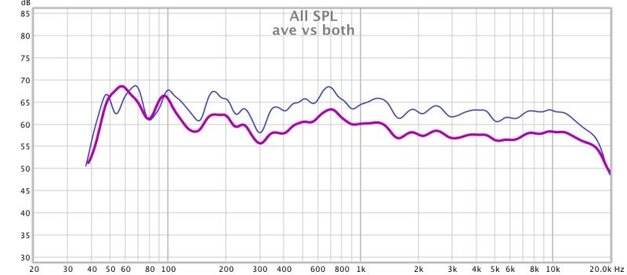mike w
Member
Thread Starter
- Joined
- Jun 28, 2017
- Posts
- 32
More
- Preamp, Processor or Receiver
- classe' audio model four
- Main Amp
- classe' audio model seventy
- Universal / Blu-ray / CD Player
- marantz sa8005 sacd
- Front Speakers
- sonus faber Cremona auditor m
- Front Height Speakers
- 36"
Hi AV NIRVANA: I should have asked this question before I bought a DSP but better never than late.
The protocol is to measure each speaker individually and then to average for an complete response. John M explained that there would be a boost in SPL when measuring both speakers as compared to measuring a single speaker. You can see this effect in the attached graph. Here is the question: Why is there a SPL boost from 100 Hz on up and not from 100 Hz on down? This matters because when I look at the average (fat line), I see a falling slope with too much bass but for the BOTH line it’s relatively flat (although lumpy). I eq’d the average line, attenuating those peaks by 5 & 6 dB and got closer to a typical room curve. I expected the sound to be leaner but it seemed too much was subtracted in the foundation of the music to me. If I evaluated only the BOTH speaker graph, I would not have taken eq action. Which graph should I focus on (besides the waterfall one)?
Mike
The protocol is to measure each speaker individually and then to average for an complete response. John M explained that there would be a boost in SPL when measuring both speakers as compared to measuring a single speaker. You can see this effect in the attached graph. Here is the question: Why is there a SPL boost from 100 Hz on up and not from 100 Hz on down? This matters because when I look at the average (fat line), I see a falling slope with too much bass but for the BOTH line it’s relatively flat (although lumpy). I eq’d the average line, attenuating those peaks by 5 & 6 dB and got closer to a typical room curve. I expected the sound to be leaner but it seemed too much was subtracted in the foundation of the music to me. If I evaluated only the BOTH speaker graph, I would not have taken eq action. Which graph should I focus on (besides the waterfall one)?
Mike















